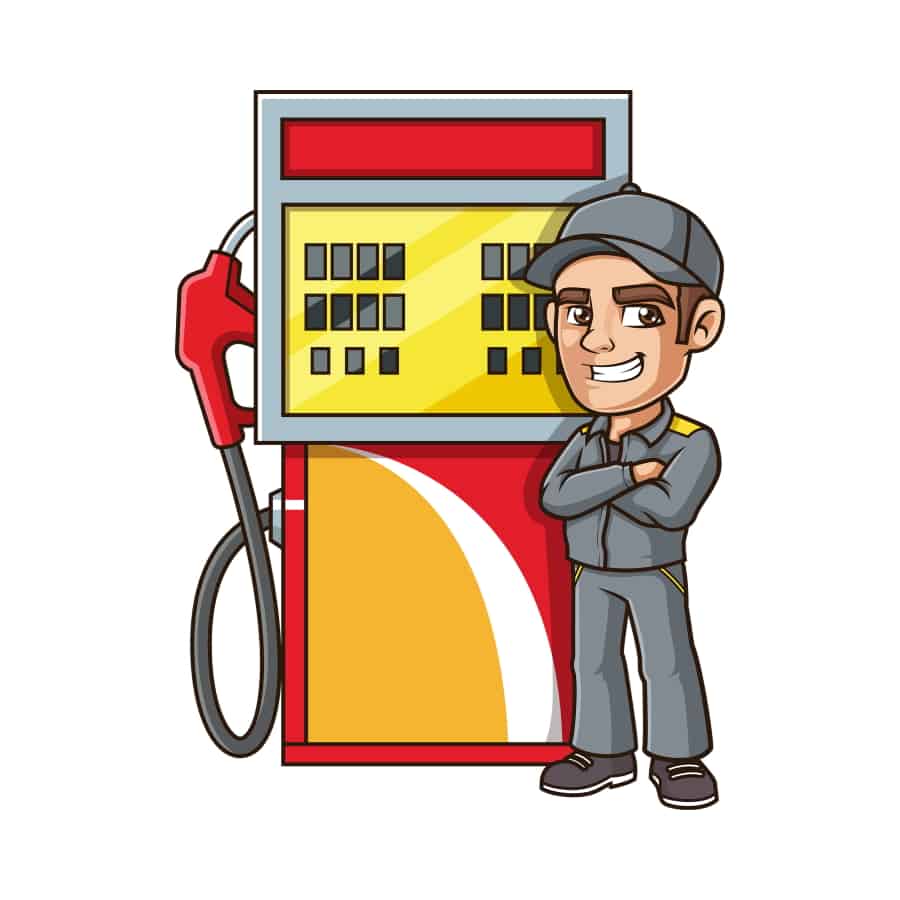We’re all familiar with the unmistakable hum of a distant lawnmower. Love them or loathe them, combustion lawnmowers are an integral part of landscaping and lawn care, as they provide ever-increasing levels of efficiency and reliability. But have you ever thought about what makes them tick?
For most lawn mowers putting in gas from a local filling station of 87 octane will work just fine. If it is a diesel mower, then you will need either diesel or bio-diesel to fill it up. For 2-stroke mowers you will need mixed gas or an oil additive to mix with the gas you purchase from the station.
That is our focus today, as we discuss the various kinds of fuels used by combustion lawnmowers. We will help first-time mower owners get to grips with the properties of certain fuel types…as well as those of the mowers that use them.

Contents
What Type Of Gas Goes In A Lawn Mower?
Most people use the word “gas” even when discussing fuel types other than gasoline.
Combustion engine mowers usually use gasoline, diesel, or a gasoline and oil mix. Some companies even sell a premixed gas-oil fuel known as “two-stroke fuel”. Bio-diesel is also emerging as a “green” alternative to other combustion fuels.
Diesel For Mowers
Diesel lawnmowers use regular diesel fuel or (depending on the manufacturer) a variation of bio-diesel fuel. Diesel packs a mightier punch per drop than regular gasoline, which makes it much more efficient. In fact, diesel has been found to have up to 12% more power than an equivalent volume of gasoline.
Diesel’s superior efficiency and output are the main reasons it is used to power commercial lawnmowers. These mowers are made to tackle large-scale jobs (parks, school grounds, golf courses, etc.) so fuel efficiency is a must. The benefits of diesel are among the reasons why, on average, diesel motors are more expensive.
Bio-Diesel For Lawn Mowers
Bio-diesel is a renewable form of diesel that is made from crops like rapeseed and soybeans. This makes it more environmentally friendly than petroleum diesel, and less toxic.
Bio-diesel is also an excellent lubricant, which is good for engine longevity. Brands like John Deere encourage the use of specific bio-diesel concentrates for their mowers.
Gasoline For Mowers
Traditional gasoline (aka “petrol”) is the most widely used fuel for combustion lawnmowers. Almost all home-use combustion mowers use straight gasoline or a gasoline-oil mix.
In the U.S., gasoline is graded in terms of fuel stability (octane). This “stability” reflects the gasoline’s combustibility at certain pressures. This means that high octane (high stability) gas requires higher pressure for spontaneous combustion than low octane gasoline. As a result, high octane is likely to produce combustion exactly when needed, which then makes the mower run at peak efficiency.
On the retail side, gasoline is categorized into:
- Regular (+/-86 octane)
- Midgrade (88-90 octane)
- Premium (90+ octane)
Most gas stations will have these three options, although they may have different names. However, the octane rating should still be visible on the pumps so you know which is which.
Mixed Gas For 2-Stroke Mowers
The other common fuel used by lawnmowers is a mix of gas and oil. A lot of brands sell this mix as two-stroke fuel but DIY mixtures are also the norm. This mix is used for mowers with 2-stroke (or 2-cycle) engines because there’s no other way to put oil in them.
You see, 2-strokes do not have a dedicated oil reservoir but they still need lubrication for piston movement and other engine functions. The only way to get oil in the machine is to mix it with fuel.
If you liked this article you will also like…
- A Gasoline Spill On Grass And Lawns – How To Fix It
- Can Lawn Mowers Use Diesel?
- How To Tell If A Lawn Mower Is A 2-Stroke Or 4-Stroke
Can You Use Regular Gas In A lawn Mower From A Gas Station?
While regular unleaded gasoline works perfectly fine, you can get better performance out of your mower by using (pricier) higher octane gasoline. The choice is, therefore a matter of cost vs performance.
4-Stroke Gas From A Filling Station
Regular unleaded gas (also known as low octane gas) can be used to power a gas mower, provided it has a 4-stroke engine. I am addressing only unleaded gasoline here, since unleaded gas is not sold at filling stations. Most won’t have access to leaded gas and it is not recommended for any mower.
All mowers can run on gasoline bought from filling stations. This goes for gasoline and diesel. This is the main way gasoline is acquired for cars, trucks, and even lawn mowers.
2-Stroke Gas And Oil From A Filling Station
If the mower in question runs on a 2-stroke motor, then you will need to use an oil-gas mix. Using straight unleaded gasoline, regardless of its octane, will result in an unlubricated engine. If the mower continues to run with this fuel, the engine will overheat and suffer serious damage or even total failure.
These oil additives can be bought from gas stations, home improvement stores, and landscaping centers. Here is what I suggest that can be shipped directly to your house for your 2-stroke engines.
Small engine maestro Briggs & Stratton also gives the proverbial seal of approval to regular fuel.
Is It Better To Use Non-Ethanol Gas In My Lawnmower?
Ethanol-free gasoline is the best choice for lawnmowers and other machines with small engines. In fact, you should be warier of ethanol content than the octane level.
Ethanol is a chemical compound that is often blended with gasoline to boost its stability (octane) for more efficient combustion. Gasoline is most commonly blended with 10% ethanol, which gives us E10 gasoline. E15 gasoline (15% ethanol blend) has also emerged in the last few years.
However, for small engines, E10 is as far as you should go. While ethanol has its benefits, it is a double-edged sword.
Ethanol contains hydrogen and oxygen atoms. Sometimes, when mixed with gasoline, ethanol may react and give off water as a by-product. Over time, this water may cause metal parts of the engine and fuel system to rust.
Not only does ethanol raise your fuel’s octane level, but it also raises its temperature. Ethanol blends are much hotter than their pure gasoline counterparts. This is bad news for small engines, and continuous use of fuel with a high ethanol blend (E15 and up) may result in overheating and eventual engine failure.
Ethanol-free gasoline has none of these drawbacks. Running your mower on this kind of fuel should see it last for much longer than machines running on ethanol blends. Unfortunately, non-ethanol fuel is not as widely available as ethanol blends. When you do find it, expect it to be significantly more expensive.
Also, despite its benefits for a mower’s engine, ethanol-free gas is not great for the environment. Without ethanol, gasoline will give off greater CO2 emissions when it combusts.
How Do You Mix Gas For A Lawnmower?
Mixing gas for a 2-stroke lawnmower is fairly easy. The machine’s instruction manual should be your first reference point, especially if the mower is still under warranty.
A lot of brands, including Briggs & Stratton, recommend a gas to oil ratio of 50:1 (one part oil per fifty parts gasoline) for the best performance.
Do not experiment to “see what works” if you are unsure of the correct mix. Visit local small engine shops or scour online forums to get help.
Will Mixed Gas Hurt A Lawnmower?
Mixed gasoline will not hurt your lawnmower if it has a 2-stroke motor. The mix itself must have the correct proportions of gas and oil.
You should never use mixed gas in a 4-stroke engine, as oil and gas have designated reserves and fillers. Running a 4-cycle mower on a gas-oil blend could result in excessive smoking and engine misfires. However, no serious damage will occur from a once-off incident.
The consequences of using an oil-gas mix in a 4-stroke could be worsened if you neglect to add oil to the oil reservoir. The mower’s engine will not be sufficiently lubricated, which can lead to overheating.
How Much Does A Gas Mower Cost?

With so many manufacturers and models, the prices of combustion mowers vary.
Gas-powered push mowers range from as little as US$140 to over $400. Self-propelled walk-behinds range from about $170 to $500. There are very few diesel-powered walk-behind mowers.
Both gas and diesel-powered riding mowers, garden tractors, and rear engine mowers range from $1,200 to over $5,000. Brands like John Deere and Cub Cadet have far pricier models though.
Zero-turn mowers can range from just over $2,000 to over $15,000!
The Final Touches On What Kind Of Gas To Put In A Lawnmower…
You can be confident going to your local filling station and using the gas there to fuel your mowers. This is how most everyone gets the gas for their lawn equipment.
You should use caution though, and make sure if you are dealing with a 2 or 4-stroke engine on your machine. This will determine if you need an oil additive.
If you have a diesel mower then only use diesel fuel. If you don’t have a diesel, then definitely do not put diesel in the gas tank.
If you want to learn more about lawn mowers and their fuels, then read these other articles…
- A Gasoline Spill On Grass And Lawns – How To Fix It
- Can Lawn Mowers Use Diesel?
- How To Tell If A Lawn Mower Is A 2-Stroke Or 4-Stroke
References
https://www.eia.gov/energyexplained/gasoline/octane-in-depth.php
https://homeguides.sfgate.com/diesel-lawn-mowers-vs-gas-lawn-mowers-74564.html

